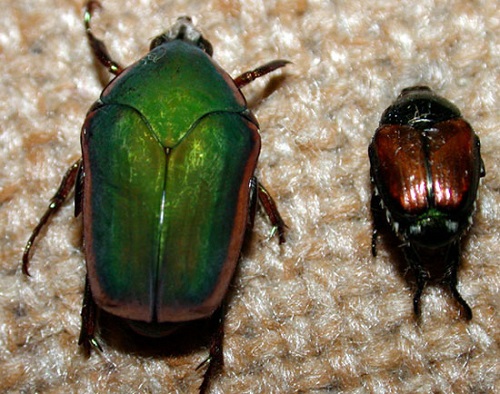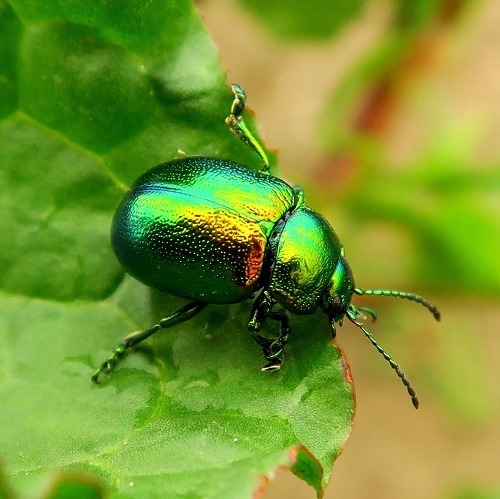June Bug vs. Japanese Beetle: Let’s explore differences & similarities between these insects in appearance and impact on plants.
When it comes to insects, there are many different types that roam our gardens and yards. Two such insects that often cause confusion due to their similar appearances are the June Bug and the Japanese Beetle. While they might look alike at first glance, there are several key differences that set them apart. Let’s have a look at June Bug vs. Japanese Beetle!
What Do Leaf Bugs Eat? Find Out
June Bug vs. Japanese Beetle

1. Physical Appearance
June Bugs: These beetles, also known as May Beetles, typically possess a moderate size and a dull coloration. Their bodies range from dark brown to reddish-brown, and they have a somewhat matte finish.
Japanese Beetles: In contrast, Japanese Beetles showcase a striking appearance with their metallic sheen. Their bodies shimmer in a vivid greenish-bronze hue, while their wing covers exhibit a coppery tone. This vibrant coloration distinguishes them from the more subdued tones of June Bugs.
2. Feeding Habits and Damage
June Bugs: As adults, June Bugs are less destructive feeders. They might nibble on leaves but generally do not cause significant harm to plants.
Japanese Beetles: However, they are notorious for their feeding behavior. They feed on a wide array of plants, consuming the tissue between leaf veins, resulting in a skeletonized appearance. This extensive feeding can lead to substantial damage and defoliation, especially in dense populations.
3. Activity Period
June Bugs: These beetles are most active during the late spring and early summer months, hence the name “June Bug.” They are often observed clumsily flying around lights in the evening.
Japanese Beetles: They are active during the peak summer months, generally from June to August. Their activity involves feeding, mating, and flying, making them more prevalent during the warmer season.
4. Habitat and Distribution
June Bugs: These insects are commonly found in grassy areas, wooded regions, and fields. Their larvae, called white grubs, reside in the soil beneath grass and vegetation.
Japanese Beetles: Japanese Beetles have a broader habitat range, inhabiting gardens, agricultural fields, suburban areas, and even forest edges. Their adaptability allows them to thrive in various environments.
5. Reproduction and Life Cycle
June Bugs: Female June Bugs lay eggs in the soil, giving rise to white grub larvae. These larvae feed on grassroots, primarily impacting the health of lawns and vegetation.
Japanese Beetles: Similarly, Japanese Beetles lay their eggs in the soil. However, their larvae feed on the roots of plants, including grass, ornamental plants, and crops. This feeding behavior can lead to significant damage, particularly in agricultural settings.
6. Economic Impact
June Bugs: While they can have localized impacts on lawns, golf courses, and grassy areas, June Bugs generally have a milder economic impact compared to Japanese Beetles.
Japanese Beetles: Due to their wide range of plant hosts and voracious feeding habits, they have a more substantial economic impact. They can damage crops, ornamental plants, and gardens, affecting agricultural and horticultural industries.
Check out Little White Bugs That Look Like Lint here
Similarities between June Bugs and Japanese Beetles
Despite their distinct differences, June Bugs and Japanese Beetles share some common characteristics due to their classification within the same family of insects, Scarabaeidae. Let’s delve into these similarities to gain a better understanding of these insects:
1. Family
Both June Bugs and Japanese Beetles belong to the Scarabaeidae family, which is a large and diverse group of beetles. This family includes a wide range of species with varying sizes, shapes, and behaviors.
The Scarabaeidae family is known for its economic and ecological importance, with many members playing roles as decomposers, pollinators, and even pests.
2. Life Cycle
Both June Bugs and Japanese Beetles go through a similar life cycle consisting of four main stages: egg, larva, pupa, and adult. The eggs of both insects are laid in the soil, where they hatch into larvae that feed on organic matter, including plant roots.
The pupal stage involves a transformation within a cocoon-like structure, leading to the emergence of the adult beetle.
3. Habitat and Distribution
June Bugs and Japanese Beetles are commonly found in North America, particularly in the United States and Canada. They inhabit a variety of environments, including gardens, lawns, agricultural fields, and wooded areas.
Their adaptability to different habitats contributes to their widespread presence.
4. Nocturnal Behavior
Both insects exhibit nocturnal behavior, meaning they are most active during the nighttime hours. June Bugs are well-known for their clumsy, fluttering flight around outdoor lights during the evening.
Similarly, Japanese Beetles are often seen feeding and mating during the day but are more active around dawn and dusk.
Learn about Tiny Bugs that Look Like Specks of Dirt here
5. Attraction to Light
Both June Bugs and Japanese Beetles are attracted to light sources, particularly artificial lights. This behavior is more pronounced in June Bugs, which are notorious for their tendency to gather around porch lights and other illuminated areas.
Japanese Beetles may also be drawn to lights but to a lesser extent.
6. Agricultural and Horticultural Impact
While Japanese Beetles are more infamous for their destructive feeding habits, both insects can cause damage to plants. June Bug larvae, known as white grubs, feed on grassroots, which can impact the health of lawns and other plants.
Japanese Beetles, as adults, are voracious feeders, consuming leaves and flowers from a wide range of plants, potentially leading to defoliation and reduced plant health.
7. Economic Considerations
The feeding activities of both insects can have economic implications. Due to their widespread damage to crops and ornamental plants, Japanese Beetles can impact agricultural and horticultural industries.
June Bugs, as white grubs, can cause damage to turfgrass, affecting the maintenance of lawns and golf courses.
Find What is a Wheel Bug? Are Wheel Bugs Dangerous? here
FAQs
1. Do June Bugs and Japanese Beetles Have Any Natural Predators?
Yes, both insects have natural predators, including birds, small mammals, and other insects like parasitic wasps, which help regulate their populations.
2. Are June Bugs and Japanese Beetles Harmful to Humans?
Neither June Bugs nor Japanese Beetles pose direct harm to humans; they do not sting or bite. However, Japanese Beetles can be a nuisance due to their attraction to lights and outdoor activities.
3. Can Japanese Beetles Fly Long Distances?
Japanese Beetles are capable of flying relatively long distances, especially during their mating and feeding activities. They can be carried by wind currents, contributing to their spread.
4. How to Control June Bugs and Japanese Beetles Populations?
To control these insects, you can use physical barriers like row covers, apply insecticides labeled for their control, introduce natural predators, or employ cultural practices like crop rotation and proper plant maintenance.



